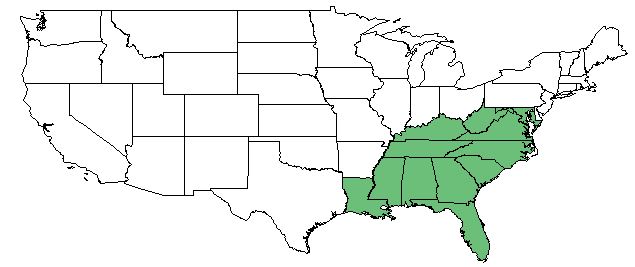Difference between revisions of "Sambucus canadensis"
(→Distribution) |
|||
| Line 31: | Line 31: | ||
==Ecology== | ==Ecology== | ||
===Habitat=== <!--Natural communities, human disturbed habitats, topography, hydrology, soils, light, fire regime requirements for removal of competition, etc.--> | ===Habitat=== <!--Natural communities, human disturbed habitats, topography, hydrology, soils, light, fire regime requirements for removal of competition, etc.--> | ||
| − | < | + | ''S. canadensis'' proliferates in streambanks, thickets, marshes, moist forests, and disturbed areas. <ref name= "Weakley 2015"> Weakley, A. S. (2015). Flora of the Southern and Mid-Atlantic States. Chapel Hill, NC, University of North Carolina Herbarium. </ref> |
| + | ===Phenology=== <!--Timing off flowering, fruiting, seed dispersal, and environmental triggers. Cite PanFlora website if appropriate: http://www.gilnelson.com/PanFlora/ --> | ||
| + | ''S. canadensis'' flowers January-August. <ref name= "PanFlora"> PanFlora Author: Gil Nelson URL: [http://www.gilnelson.com/PanFlora/ http://www.gilnelson.com/PanFlora/] Date Accessed: 5/29/18 </ref> The leaflets, particularly of young shoots or stunted sprouts, are often variegated. This is one of the first woody plants to leaf out in the spring. The variation is clinal, and bipinnate leaves are seen as far north as coastal NC. <ref name= "Weakley 2015"/> | ||
<!--===Seed dispersal===--> | <!--===Seed dispersal===--> | ||
<!--===Seed bank and germination===--> | <!--===Seed bank and germination===--> | ||
| − | + | ===Fire ecology=== <!--Fire tolerance, fire dependence, adaptive fire responses--> | |
| + | ''S. canadensis'' is not fire resistant, but has a medium fire tolerance. <ref name= "USDA Plant Database"/> | ||
<!--===Pollination===--> | <!--===Pollination===--> | ||
| − | + | ===Use by animals=== <!--Herbivory, granivory, insect hosting, etc.--> | |
| + | ''S. canadensis'' is some palatable to browsing animals. <ref name= "USDA Plant Database"/> | ||
<!--==Diseases and parasites==--> | <!--==Diseases and parasites==--> | ||
Revision as of 14:35, 29 May 2018
| Sambucus canadensis | |
|---|---|

| |
| Photo by John Hilty hosted at IllinoisWildflowers.info | |
| Scientific classification | |
| Kingdom: | Plantae |
| Division: | Magnoliophyta - Flowering plants |
| Class: | Magnoliopsida - Dicots |
| Order: | Dipsacales |
| Family: | Caprifoliaceae |
| Genus: | Sambucus |
| Species: | S. canadensis |
| Binomial name | |
| Sambucus canadensis (L.) R. Boll | |

| |
| Natural range of Sambucus canadensis from USDA NRCS Plants Database. | |
Contents
Taxonomic Notes
Synonyms: S. nigra Linnaeus ssp. canadensis (Linnaeus) R. Bolli
Varieties: none
Description
S. canadensis is a perennial shrub/tree of the Caprifoliaceae family native to North America, Canada, and Puerto Rico and introduced to Hawaii, the U.S. Virgin Islands, and the Pacific Basin. [1]
Distribution
S. canadensis is found: everywhere in the United States excluding Washington, Oregon, Idaho, Nevada, and Utah; the Manitoba, Ontario, Quebec, New Brunswick, and Nova Scotia areas of Canada; every island of Hawaii; Puerto Rico; the Pacific Basin; and the U.S. Virgin Islands. [1]
Ecology
Habitat
S. canadensis proliferates in streambanks, thickets, marshes, moist forests, and disturbed areas. [2]
Phenology
S. canadensis flowers January-August. [3] The leaflets, particularly of young shoots or stunted sprouts, are often variegated. This is one of the first woody plants to leaf out in the spring. The variation is clinal, and bipinnate leaves are seen as far north as coastal NC. [2]
Fire ecology
S. canadensis is not fire resistant, but has a medium fire tolerance. [1]
Use by animals
S. canadensis is some palatable to browsing animals. [1]
Conservation and Management
Cultivation and restoration
Photo Gallery
References and notes
- ↑ 1.0 1.1 1.2 1.3 USDA Plant Database https://plants.usda.gov/core/profile?symbol=SANIC4#
- ↑ 2.0 2.1 Weakley, A. S. (2015). Flora of the Southern and Mid-Atlantic States. Chapel Hill, NC, University of North Carolina Herbarium.
- ↑ PanFlora Author: Gil Nelson URL: http://www.gilnelson.com/PanFlora/ Date Accessed: 5/29/18